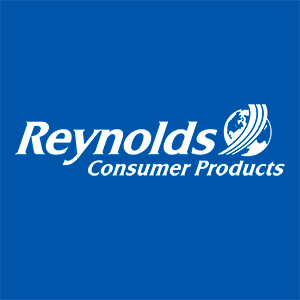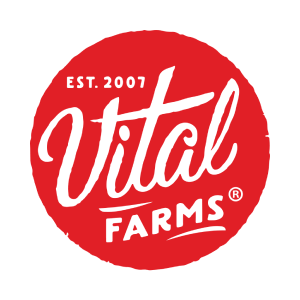
Mission Produce (AVO)
We wouldn’t buy Mission Produce. Its poor returns on capital indicate it barely generated any profits, a must for high-quality companies.― StockStory Analyst Team
1. News
2. Summary
Why We Think Mission Produce Will Underperform
Founded in 1983 in California, Mission Produce (NASDAQ:AVO) grows, packages, and distributes avocados.
- Projected sales decline of 3.9% for the next 12 months points to a tough demand environment ahead
- Easily substituted products (and therefore stiff competition) result in an inferior gross margin of 11.1% that must be offset through higher volumes
- Subscale operations are evident in its revenue base of $1.43 billion, meaning it has fewer distribution channels than its larger rivals


Mission Produce doesn’t meet our quality standards. We’ve identified better opportunities elsewhere.
Why There Are Better Opportunities Than Mission Produce
High Quality
Investable
Underperform
Why There Are Better Opportunities Than Mission Produce
At $11.82 per share, Mission Produce trades at 16.4x forward P/E. This multiple expensive for its subpar fundamentals.
Paying up for elite businesses with strong earnings potential is better than investing in lower-quality companies with shaky fundamentals. That’s how you avoid big downside over the long term.
3. Mission Produce (AVO) Research Report: Q2 CY2025 Update
Avocado company Mission Produce (NASDAQ:AVO) reported Q2 CY2025 results exceeding the market’s revenue expectations, with sales up 10.4% year on year to $357.7 million. Its non-GAAP profit of $0.26 per share was 79.3% above analysts’ consensus estimates.
Mission Produce (AVO) Q2 CY2025 Highlights:
- Revenue: $357.7 million vs analyst estimates of $320.4 million (10.4% year-on-year growth, 11.7% beat)
- Adjusted EPS: $0.26 vs analyst estimates of $0.15 (79.3% beat)
- Adjusted EBITDA: $32.6 million vs analyst estimates of $25 million (9.1% margin, 30.4% beat)
- Operating Margin: 5.9%, in line with the same quarter last year
- Free Cash Flow Margin: 6.3%, down from 10.8% in the same quarter last year
- Sales Volumes rose 10% year on year (-10% in the same quarter last year)
- Market Capitalization: $891.9 million
Company Overview
Founded in 1983 in California, Mission Produce (NASDAQ:AVO) grows, packages, and distributes avocados.
The company began as a small and modest avocado distributor. Over time, however, Mission Produce grew organically and also capitalized on strategic acquisitions of avocado farms and processing plants that allowed the company to cement itself as a vertically-integrated and dominant player in the industry.
The product is self explanatory, but Mission Produce differentiates itself with the scale and technology that allows their product to reach consumers in near-peak or peak condition. Because let’s be honest, no one likes that rock-hard green avocado that takes a long time to ripen, and on the other side of the coin, no one likes an over-ripened or rotten avocado either.
The core customer tends to be a health conscious shopper, although avocados are making their way more into the mainstream through Mexican dishes, salads, and avocado toast. Mission Produce’s offering can be found in many locations selling fresh fruit and vegetables including supermarkets, club stores, and large-format general merchandise retailers that have grocery sections.
4. Perishable Food
The perishable food industry is diverse, encompassing large-scale producers and distributors to specialty and artisanal brands. These companies sell produce, dairy products, meats, and baked goods and have become integral to serving modern American consumers who prioritize freshness, quality, and nutritional value. Investing in perishable food stocks presents both opportunities and challenges. While the perishable nature of products can introduce risks related to supply chain management and shelf life, it also creates a constant demand driven by the necessity for fresh food. Companies that can efficiently manage inventory, distribution, and quality control are well-positioned to thrive in this competitive market. Navigating the perishable food industry requires adherence to strict food safety standards, regulations, and labeling requirements.
Competitors in the avocado industry include Calavo Growers (NASDAQ:CVGW), private company West Pak Avocado, and some smaller, independent growers and distributors.
5. Revenue Growth
Reviewing a company’s long-term sales performance reveals insights into its quality. Any business can have short-term success, but a top-tier one grows for years.
With $1.43 billion in revenue over the past 12 months, Mission Produce is a small consumer staples company, which sometimes brings disadvantages compared to larger competitors benefiting from economies of scale and negotiating leverage with retailers. On the bright side, it can grow faster because it has a longer list of untapped store chains to sell into.
As you can see below, Mission Produce’s sales grew at a decent 10.9% compounded annual growth rate over the last three years as consumers bought more of its products.

This quarter, Mission Produce reported year-on-year revenue growth of 10.4%, and its $357.7 million of revenue exceeded Wall Street’s estimates by 11.7%.
Looking ahead, sell-side analysts expect revenue to decline by 12.1% over the next 12 months, a deceleration versus the last three years. This projection is underwhelming and implies its products will see some demand headwinds.
6. Volume Growth
Revenue growth can be broken down into changes in price and volume (the number of units sold). While both are important, volume is the lifeblood of a successful staples business as there’s a ceiling to what consumers will pay for everyday goods; they can always trade down to non-branded products if the branded versions are too expensive.
Mission Produce’s average quarterly volume growth was a healthy 1.1% over the last two years. This is pleasing because it shows consumers are purchasing more of its products. 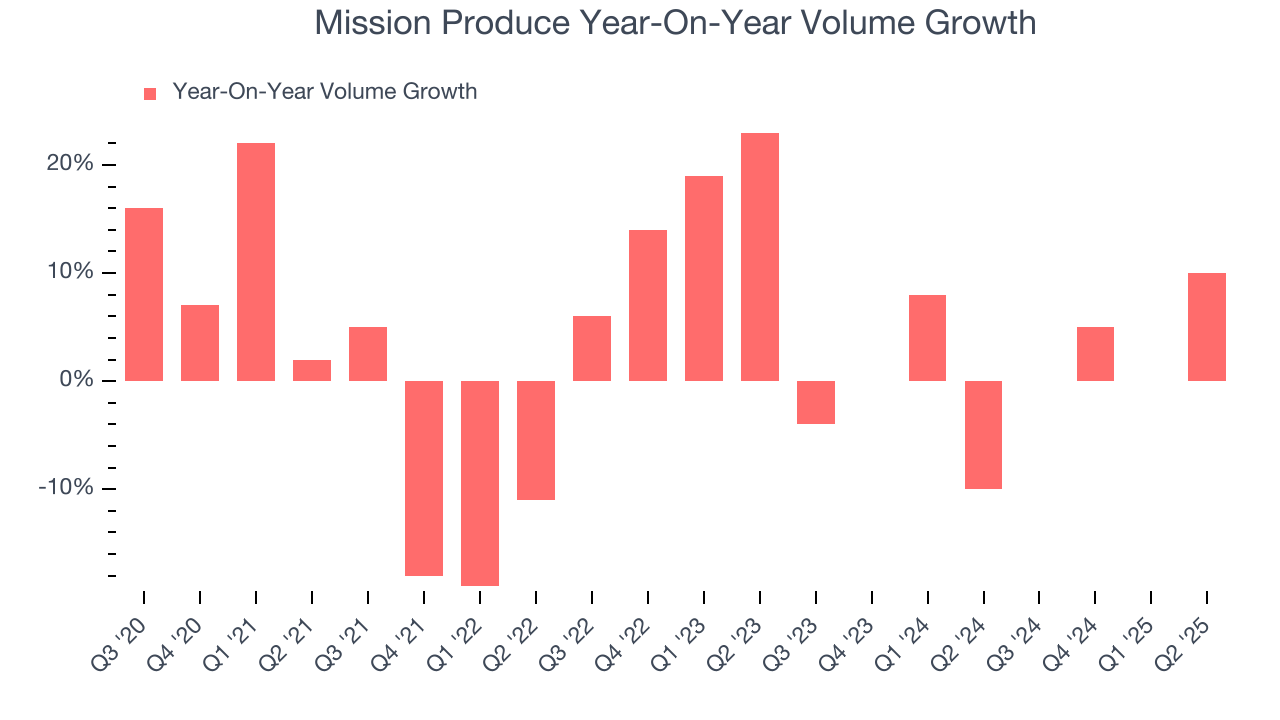
In Mission Produce’s Q2 2025, sales volumes jumped 10% year on year. This result was an acceleration from its historical levels, certainly a positive signal.
7. Gross Margin & Pricing Power
Mission Produce has bad unit economics for a consumer staples company, signaling it operates in a competitive market and lacks pricing power because its products can be substituted. As you can see below, it averaged a 11.2% gross margin over the last two years. That means Mission Produce paid its suppliers a lot of money ($88.85 for every $100 in revenue) to run its business. 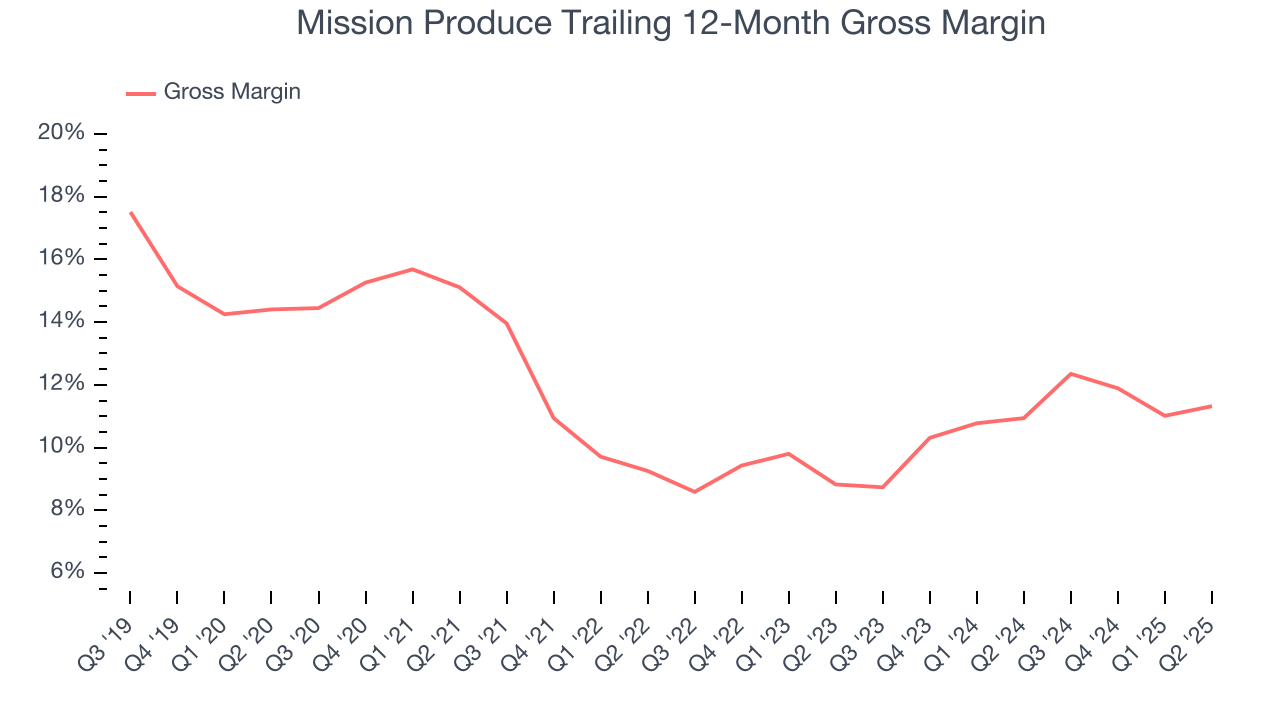
Mission Produce produced a 12.6% gross profit margin in Q2, up 1.2 percentage points year on year and easily exceeding analysts’ estimates. On a wider time horizon, the company’s full-year margin has remained steady over the past four quarters, suggesting its input costs (such as raw materials and manufacturing expenses) have been stable and it isn’t under pressure to lower prices.
8. Operating Margin
Operating margin is an important measure of profitability accounting for key expenses such as marketing and advertising, IT systems, wages, and other administrative costs.
Mission Produce’s operating margin might fluctuated slightly over the last 12 months but has generally stayed the same, averaging 4.3% over the last two years. This profitability was paltry for a consumer staples business and caused by its suboptimal cost structureand low gross margin.
Analyzing the trend in its profitability, Mission Produce’s operating margin might fluctuated slightly but has generally stayed the same over the last year. This raises questions about the company’s expense base because its revenue growth should have given it leverage on its fixed costs, resulting in better economies of scale and profitability.
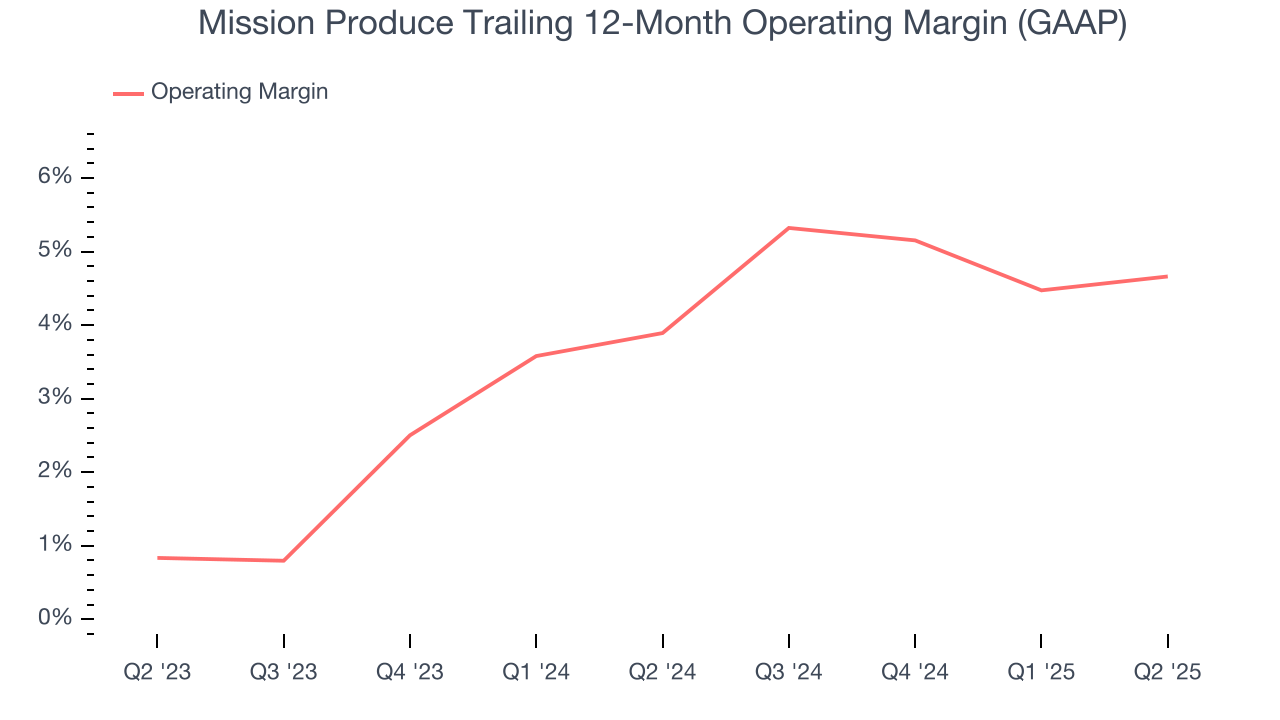
This quarter, Mission Produce generated an operating margin profit margin of 5.9%, in line with the same quarter last year. This indicates the company’s cost structure has recently been stable.
9. Earnings Per Share
Revenue trends explain a company’s historical growth, but the change in earnings per share (EPS) points to the profitability of that growth – for example, a company could inflate its sales through excessive spending on advertising and promotions.
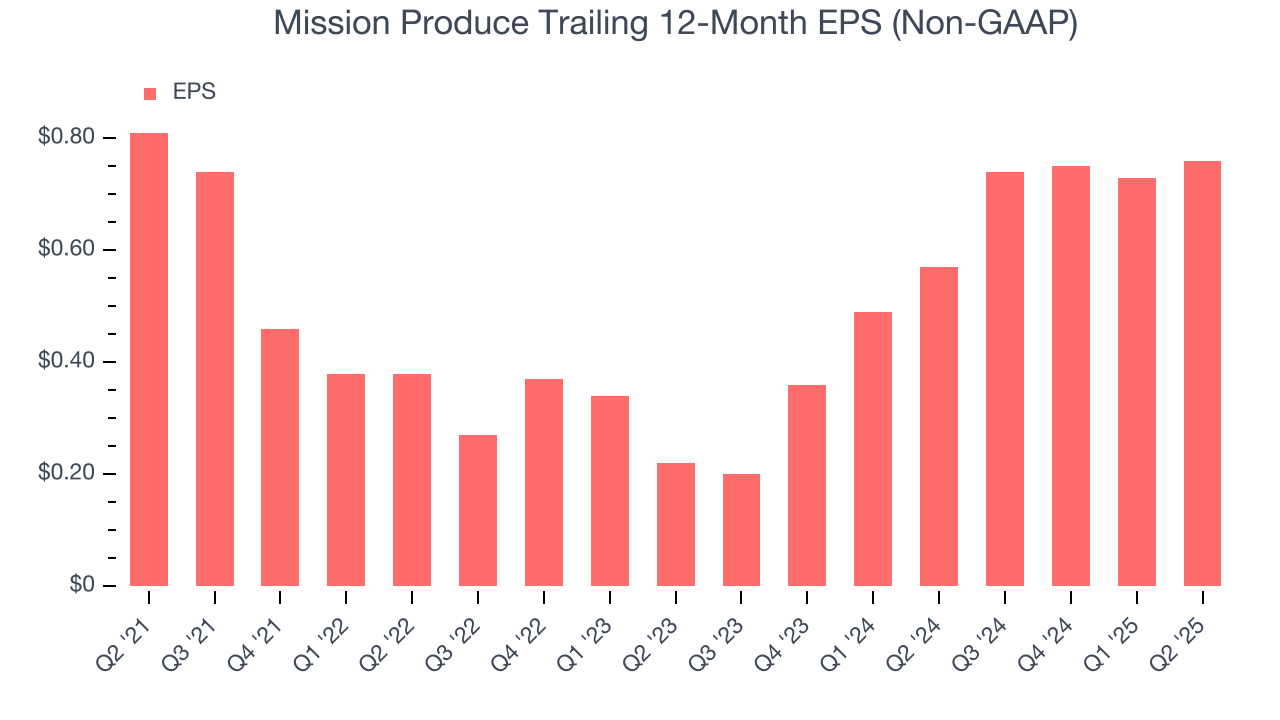
In Q2, Mission Produce reported adjusted EPS of $0.26, up from $0.23 in the same quarter last year. This print easily cleared analysts’ estimates, and shareholders should be content with the results. We also like to analyze expected EPS growth based on Wall Street analysts’ consensus projections, but there is insufficient data.
10. Cash Is King
Although earnings are undoubtedly valuable for assessing company performance, we believe cash is king because you can’t use accounting profits to pay the bills.
Mission Produce has shown mediocre cash profitability over the last two years, giving the company limited opportunities to return capital to shareholders. Its free cash flow margin averaged 3%, subpar for a consumer staples business.
Taking a step back, we can see that Mission Produce’s margin dropped by 4.7 percentage points over the last year. Almost any movement in the wrong direction is undesirable because of its already low cash conversion. If the trend continues, it could signal it’s becoming a more capital-intensive business.
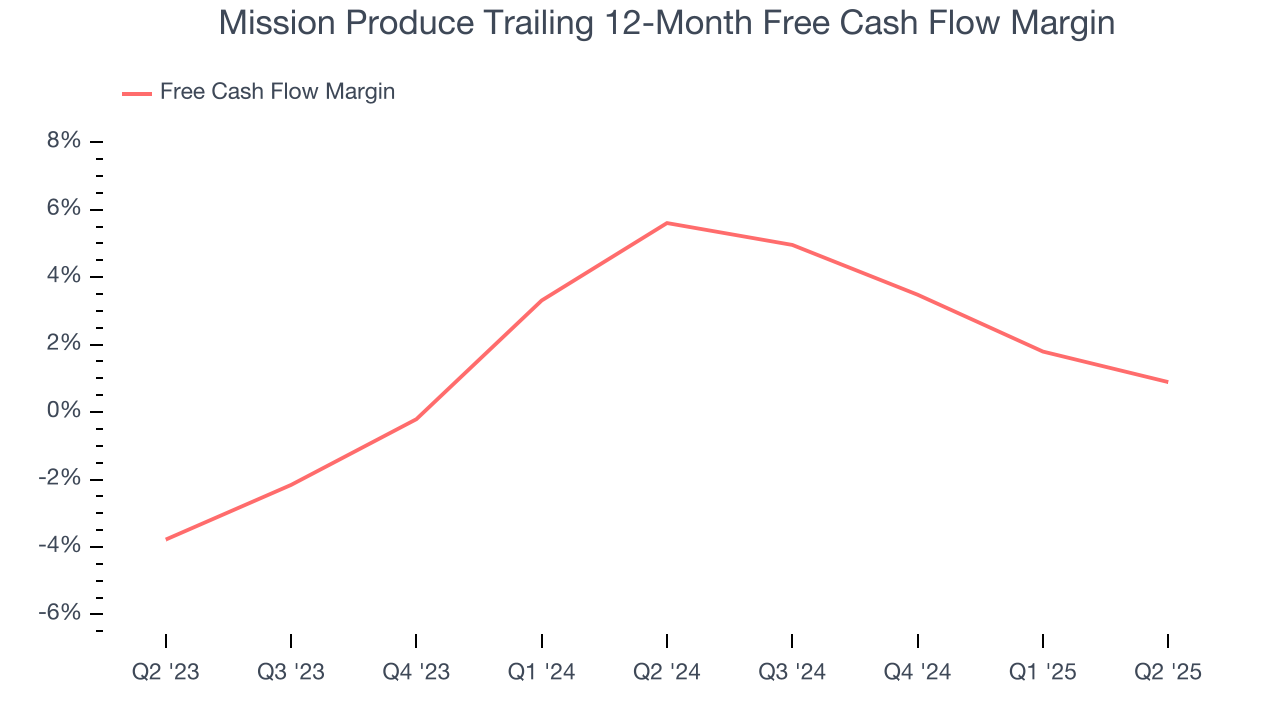
Mission Produce’s free cash flow clocked in at $22.6 million in Q2, equivalent to a 6.3% margin. The company’s cash profitability regressed as it was 4.5 percentage points lower than in the same quarter last year, but it’s still above its two-year average. We wouldn’t put too much weight on this quarter’s decline because investment needs can be seasonal, causing short-term swings. Long-term trends trump temporary fluctuations.
11. Return on Invested Capital (ROIC)
EPS and free cash flow tell us whether a company was profitable while growing its revenue. But was it capital-efficient? Enter ROIC, a metric showing how much operating profit a company generates relative to the money it has raised (debt and equity).
Mission Produce historically did a mediocre job investing in profitable growth initiatives. Its five-year average ROIC was 4.8%, lower than the typical cost of capital (how much it costs to raise money) for consumer staples companies.
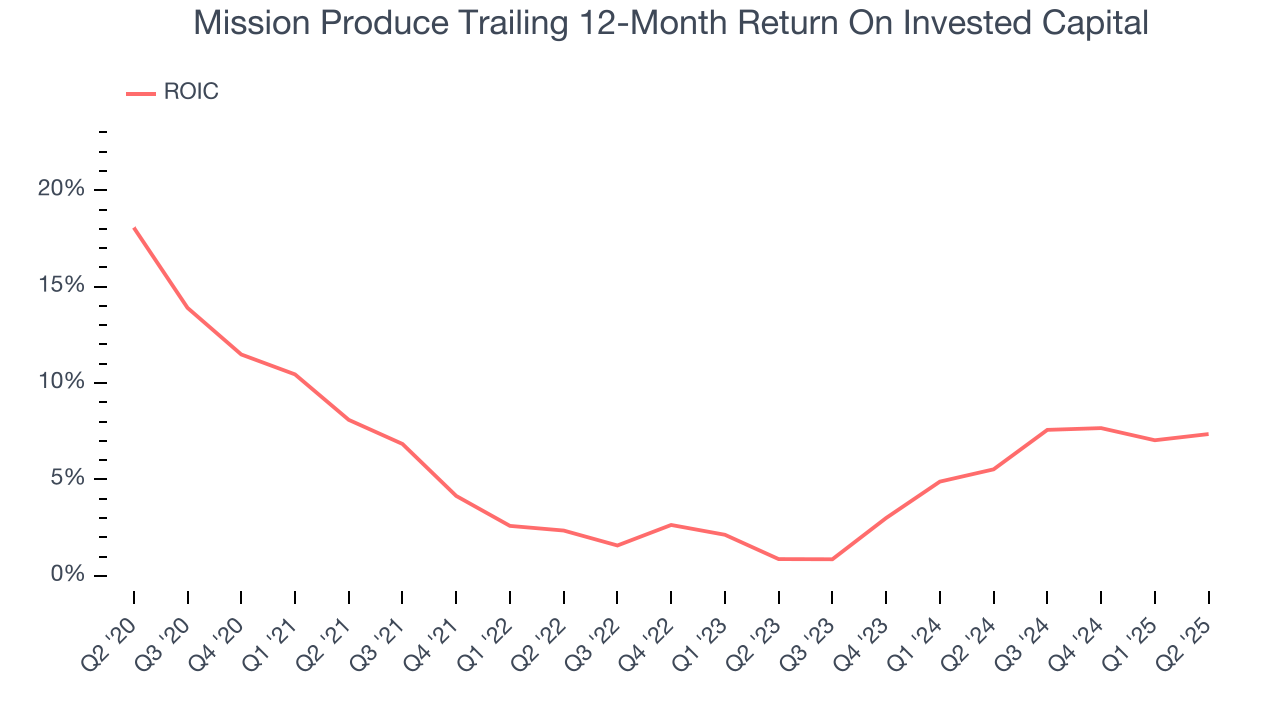
12. Balance Sheet Assessment
Mission Produce reported $43.7 million of cash and $235.3 million of debt on its balance sheet in the most recent quarter. As investors in high-quality companies, we primarily focus on two things: 1) that a company’s debt level isn’t too high and 2) that its interest payments are not excessively burdening the business.
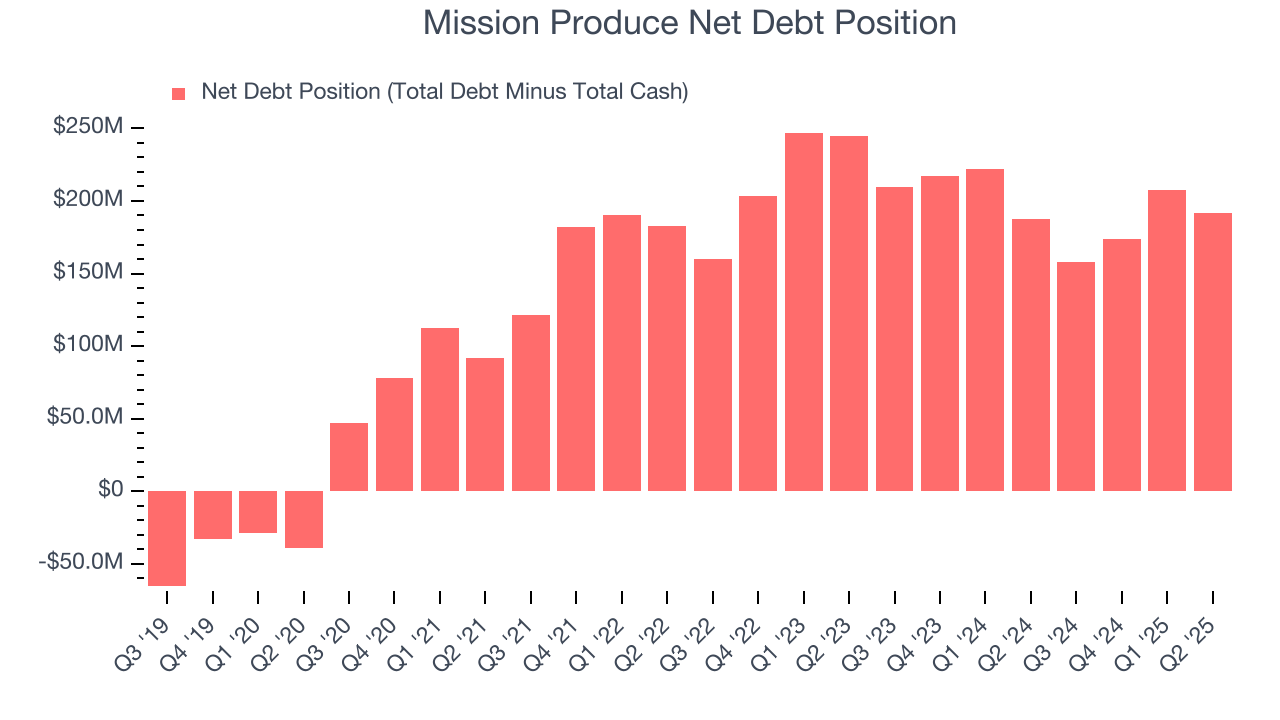
With $106.3 million of EBITDA over the last 12 months, we view Mission Produce’s 1.8× net-debt-to-EBITDA ratio as safe. We also see its $3.5 million of annual interest expenses as appropriate. The company’s profits give it plenty of breathing room, allowing it to continue investing in growth initiatives.
13. Key Takeaways from Mission Produce’s Q2 Results
It was good to see Mission Produce beat analysts’ EPS expectations this quarter. We were also excited its gross margin outperformed Wall Street’s estimates by a wide margin. Zooming out, we think this was a solid print. The stock traded up 4% to $13.38 immediately after reporting.
14. Is Now The Time To Buy Mission Produce?
Updated: December 4, 2025 at 9:50 PM EST
Before making an investment decision, investors should account for Mission Produce’s business fundamentals and valuation in addition to what happened in the latest quarter.
We see the value of companies helping consumers, but in the case of Mission Produce, we’re out. Although its revenue growth was solid over the last three years, it’s expected to deteriorate over the next 12 months and its gross margins make it more challenging to reach positive operating profits compared to other consumer staples businesses. And while the company’s EPS growth over the last three years has been fantastic, the downside is its projected EPS for the next year is lacking.
Mission Produce’s P/E ratio based on the next 12 months is 16.4x. At this valuation, there’s a lot of good news priced in - we think there are better stocks to buy right now.
Wall Street analysts have a consensus one-year price target of $17 on the company (compared to the current share price of $11.99).
Although the price target is bullish, readers should exercise caution because analysts tend to be overly optimistic. The firms they work for, often big banks, have relationships with companies that extend into fundraising, M&A advisory, and other rewarding business lines. As a result, they typically hesitate to say bad things for fear they will lose out. We at StockStory do not suffer from such conflicts of interest, so we’ll always tell it like it is.


